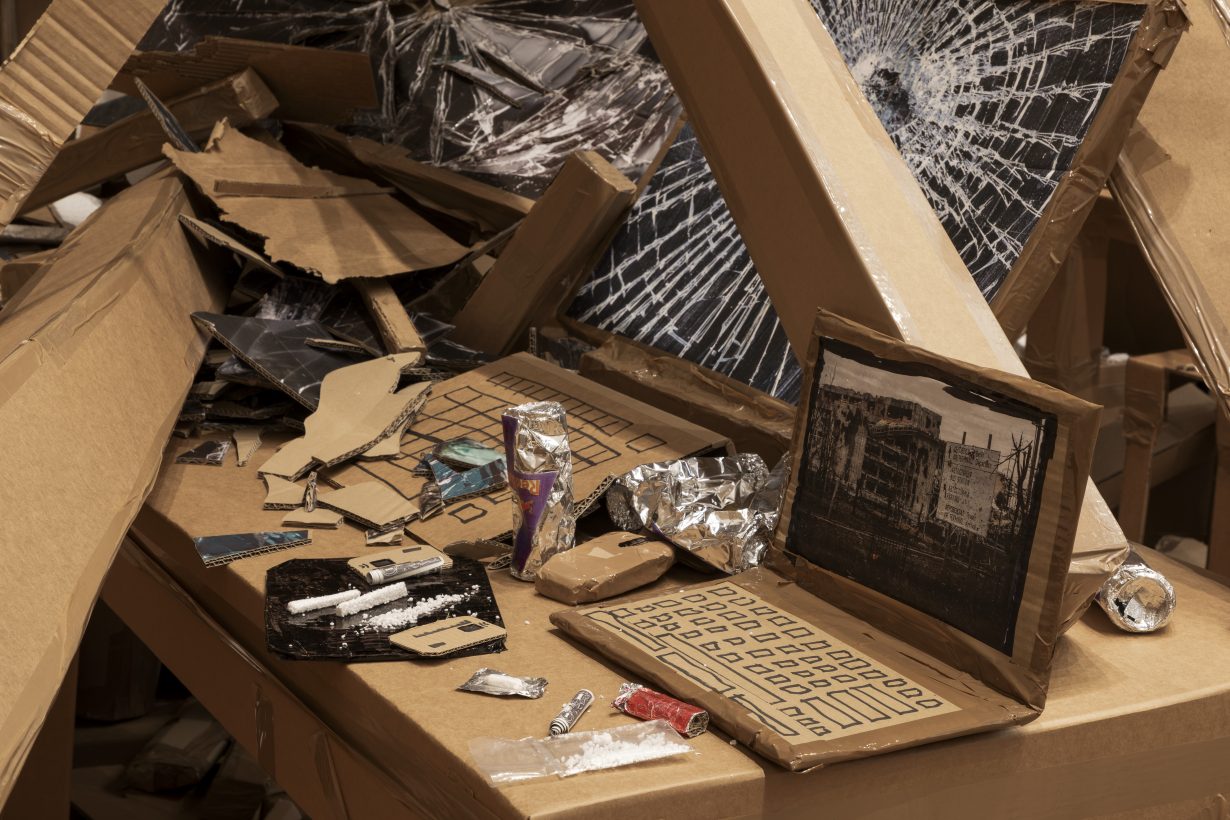The artist’s single-work exhibition, Fake it, Fake it – till you Fake it. at Gladstone Gallery, New York, captures our collective online disquiet
In this single-work exhibition, Thomas Hirschhorn wages a philosophical war using cardboard, tape, printed images, polystyrene and aluminium foil. These elements come together to form a wall-to-wall installation that doubles as a polemic against the false promises of Silicon Valley and the threat of ‘robotic control’, a phrase in the text the artist has spraypainted on the wall by the entrance, which begins, ‘Dear World, we are talking about “Artificial Intelligence” – but why only “Intelligence”, why not “Artificial Willpower?” “Artificial Belief?”’ and concludes, ‘BE AWARE OR BE NEXT!’
Hirschhorn, a self-proclaimed ‘artist, worker, soldier’, is known for what he calls ‘doing art politically’, but in the thick of Fake it, Fake it – till you Fake it. (2023), his handcrafted labour feels less like the illustration of a political problem than an imagined representation of the seedy internet café that comes to mind when hearing about ‘sudden gamer death’ and other social ills, or a spoof of a teenager’s messy bedroom. Rows of cardboard tables are littered with cardboard game controllers, cardboard smartphones, cardboard credit cards, chunks of polystyrene carved into coffee mugs and pizza slices, tinfoil cylinders given inkjet-printed Red Bull labels and lines of polystyrene ‘cocaine’.
The artist once said in an interview, ‘To make art politically means to choose materials that do not intimidate’. Like a paper fortress, Fake it exemplifies this point. Its informality begets a sense of comfort and public-mindedness, as have Hirschhorn’s past projects, such as his Gramsci Monument (2013), where the artist collaborated with residents of Forest Houses, a New York City Housing Authority development in the Bronx, to construct a series of plywood pavilions dedicated to the Italian Marxist thinker. Compared to the collaborative premise of Gramsci Monument, Fake takes a more confrontational approach. Many of the dummy computer monitors at Gladstone are cut into shards and made to look as if they’ve been fractured by bullets. Their broken ‘screens’ display a mixture of frames from first-person shooter games and journalistic photos of war-stricken urban centres.

It is tempting but perhaps too easy to read this fever dream in the vein of cyberpunk, wherein society collapses at the hands of technology and AI, and simulacra steadily encroach on physical space, fusing with its shabby materiality. So is viewing it as a straightforward critique of nihilism in the face of false utopias and disinformation. Like past works, such as Hirschhorn’s Bataille Monument (2002), for which he transported Documenta visitors away from the exhibition site to a majority-Turkish suburb of Kassel, and his ‘Ur-Collage’ (2008), in which he juxtaposed fashion editorials with images of mutilated war victims, the effectiveness of Fake it hinges on its ability to produce visual and conceptual dissonance.
The installation swarms with contrasts. Cutout printed images of CGI soldiers, armed and uniformed, dangle from the ceiling on skeins of clear masking tape. Animated by a whirring industrial fan perched on two paint-spattered step ladders, they twirl like mobiles at eye level, evoking various emotions based on viewers’ past encounters with such personnel. Cutouts of emojis – yellow smiles, purple devils – fill the airspace between the soldiers and the ceiling, their beady eyes and stock expressions clashing with the videogame avatars’ uncannily lifelike visages. Covering one of the gallery’s walls is a grainy black-and-white photo of a building’s crumbling facade. The totality of this archival image is disrupted by the swinging ornaments. Smiley faces sporting sunglasses and heart-shaped eyes appear to mock the scene of destruction and the war it symbolises.
At first blush, the installation may seem juvenile in spirit, in terms of both the scene it depicts – a den of drugs and videogames – and the confidence with which it dispatches its abstract philosophical arguments. What might prove illuminating, once the viewer has read and turned over every possible meaning of the writing on the wall, would be to try hunting for the sources of the photographs reproduced among the cardboard effigies: a simple Google search yields dozens of comparable images of modern ruins captured in Ukraine and the Gaza Strip. In this sense, without spelling it out plainly, Fake it taps into the trepidation of today’s netizens in the face of con- current global conflicts and surfaces the structural causes of our collective disquiet.
Fake it, Fake it – till you Fake it. at Gladstone Gallery, New York, 24 January – 2 March
